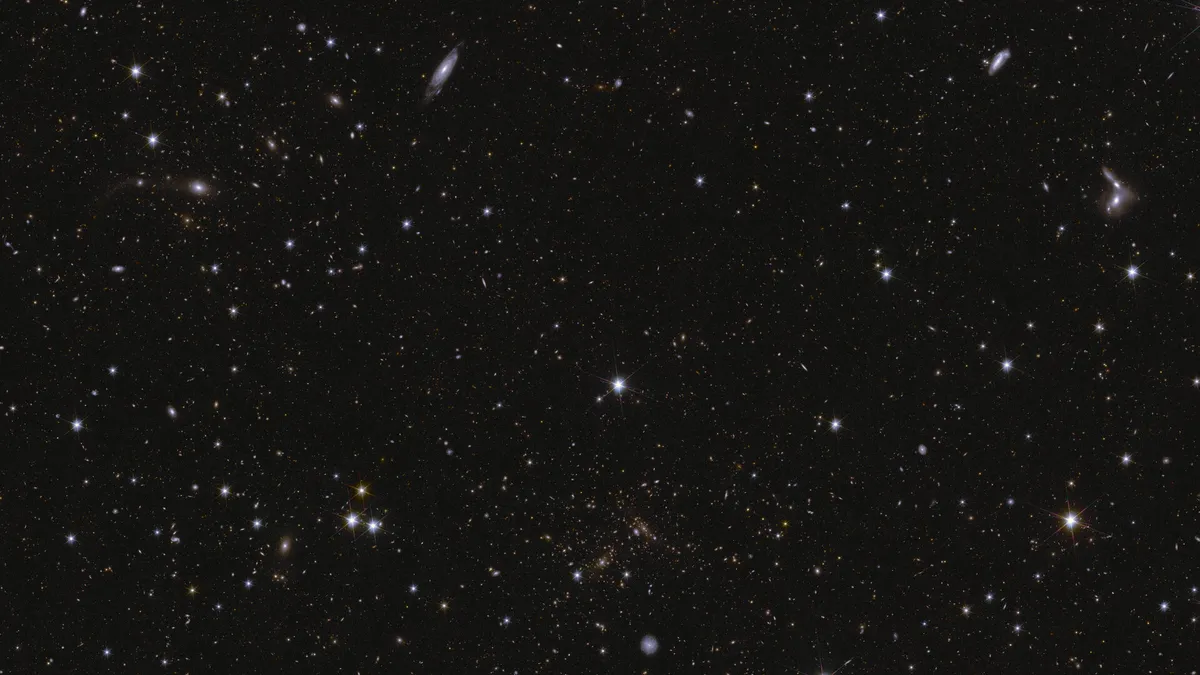
On 19 March 2025, the European Space Agency’s Euclid mission unveiled its first batch of survey data, offering an exciting preview of its deep fields. This remarkable dataset showcases hundreds of thousands of galaxies of various shapes and sizes, providing a glimpse into their large-scale organization within the cosmic web. The release includes three expansive mosaics covering a significant area of the sky, along with numerous galaxy clusters, active galactic nuclei, and transient phenomena.
One of the standout features of this data release is the first classification survey of more than 380,000 galaxies and 500 gravitational lens candidates. This classification was achieved through a collaborative effort that combined the power of artificial intelligence (AI) with the dedication of citizen scientists. This rich dataset sets the stage for the myriad topics that the dark Universe detective Euclid is poised to explore.
“Euclid shows itself once again to be the ultimate discovery machine," remarked ESA’s Director of Science, Prof. Carole Mundell. “It is surveying galaxies on the grandest scale, enabling us to explore our cosmic history and the invisible forces shaping our Universe.” The release of this initial dataset represents a treasure trove of information for scientists, allowing them to address some of the most profound questions in modern science.
Euclid has already pinpointed three specific areas in the sky where it will conduct its deepest observations. Within just one week of observations, the mission identified an astonishing 26 million galaxies, some of which are located up to 10.5 billion light-years away. These fields also host a small population of bright quasars that are visible from even greater distances. As the mission progresses, Euclid will revisit these regions multiple times, capturing an increasingly complete view of the cosmos, ultimately contributing to a comprehensive cosmic atlas by the end of its nominal mission in 2030.
Valeria Pettorino, ESA’s Euclid project scientist, emphasized the significance of the data collected from the deep field areas. “It’s impressive how one observation of the deep field areas has already given us a wealth of data that can be used for a variety of purposes in astronomy,” she said. Each deep field will be observed between 30 and 52 times during Euclid’s six-year mission, allowing scientists to refine their understanding and improve the resolution of these observations.
To unlock the mysteries of the Universe, Euclid employs high-resolution imaging through its visible instrument (VIS), while its near-infrared instrument (NISP) is crucial for determining galaxy distances and masses. The initial images already reveal the large-scale organization of galaxies within the cosmic web, illustrating how ordinary and dark matter filaments intertwine throughout the cosmos.
Euclid is on track to capture images of over 1.5 billion galaxies over the course of its six-year mission, transmitting approximately 100 GB of data daily. This enormous dataset presents both opportunities for discovery and significant challenges in terms of analysis and cataloguing. The integration of advanced artificial intelligence algorithms alongside thousands of human citizen scientists has proven vital in tackling these challenges.
“We’re at a pivotal moment in terms of how we tackle large-scale surveys in astronomy,” stated Mike Walmsley, a scientist from the Euclid Consortium at the University of Toronto. “AI is a fundamental and necessary part of our process to fully exploit Euclid’s vast dataset.” A major achievement of this initiative is the first detailed catalogue of over 380,000 galaxies, classified based on features such as spiral arms and tidal tails, indicative of merging galaxies. This catalogue, created by the ‘Zoobot’ AI algorithm, is a testament to the power of collaborative science.
Euclid also employs the phenomenon of gravitational lensing to investigate the distribution of dark matter across the Universe. When light from distant galaxies is bent and distorted by normal and dark matter in the foreground, it reveals crucial information about the Universe’s structure. The mission has released a preliminary catalogue of 500 galaxy-galaxy strong lens candidates, most of which were previously unknown.
The potential for Euclid is immense, with plans to identify around 100,000 galaxy-galaxy strong lenses by the end of the mission. Additionally, the mission aims to measure ‘weak’ lensing effects, which involve subtle distortions that can only be detected through statistical analysis of large galaxy samples. This comprehensive approach will enable Euclid to create a 3D view of dark matter’s distribution throughout the cosmos.
As of 19 March 2025, Euclid has observed approximately 2000 square degrees of its total survey area, which is 14,000 square degrees. The data released on this date highlights the incredible potential of combining Euclid's capabilities with AI and citizen science efforts, creating a robust discovery engine that will be essential for analyzing the vast volumes of data generated by the mission.
The first major cosmology data release is scheduled for October 2026, which will include data accumulated from multiple passes over the deep field locations. This release promises to enhance our understanding of the Universe significantly.
Explore the three deep field previews in ESASky starting from 19 March 2025, and witness the beginning of a new chapter in astronomical research.
For further information about the Euclid mission and its groundbreaking discoveries, please contact ESA Media Relations at media@esa.int.